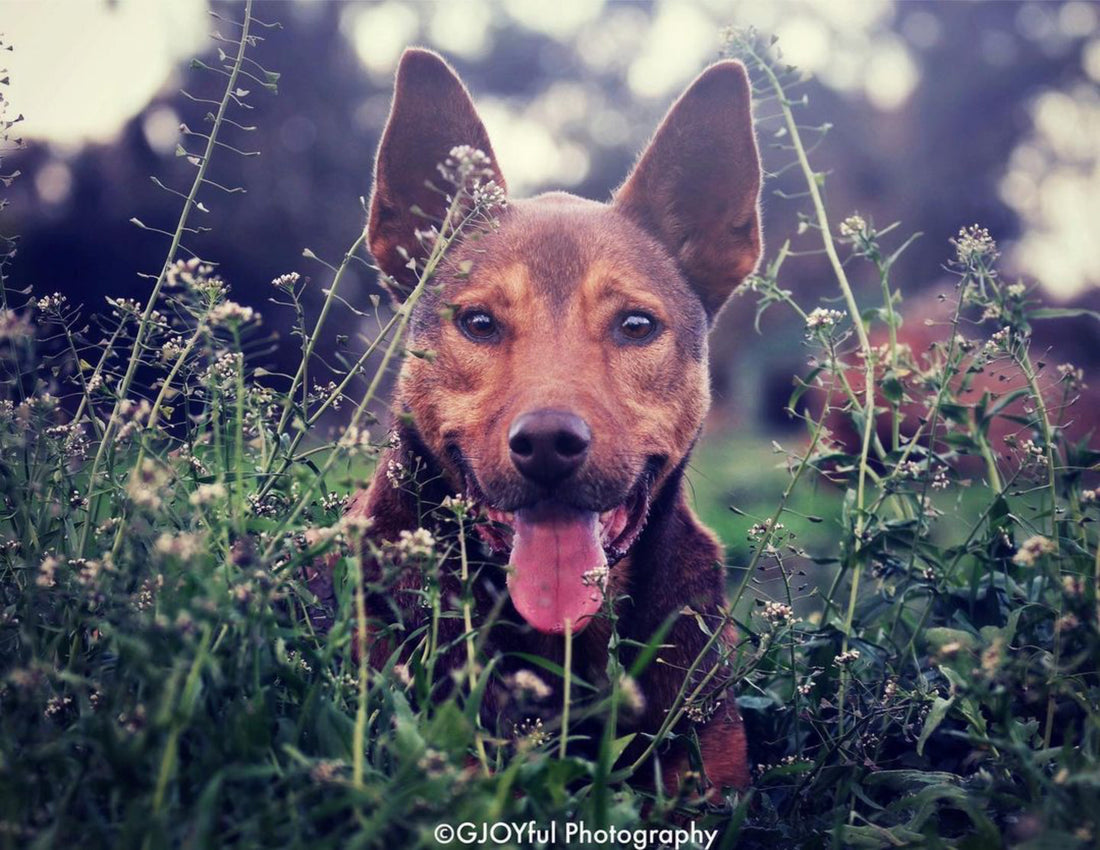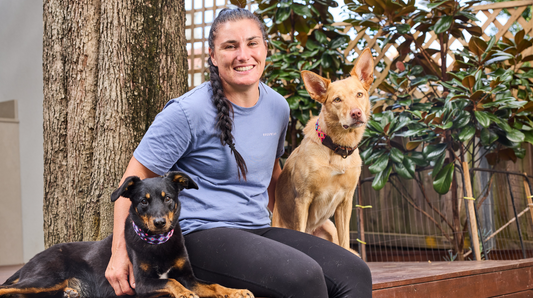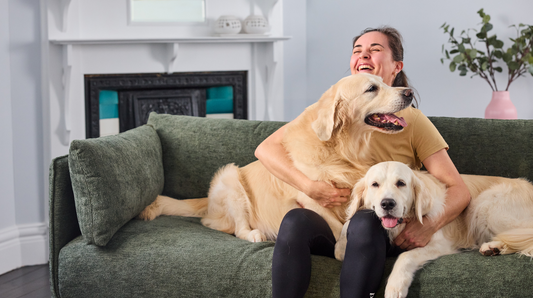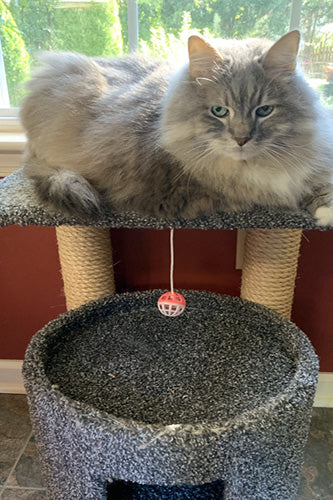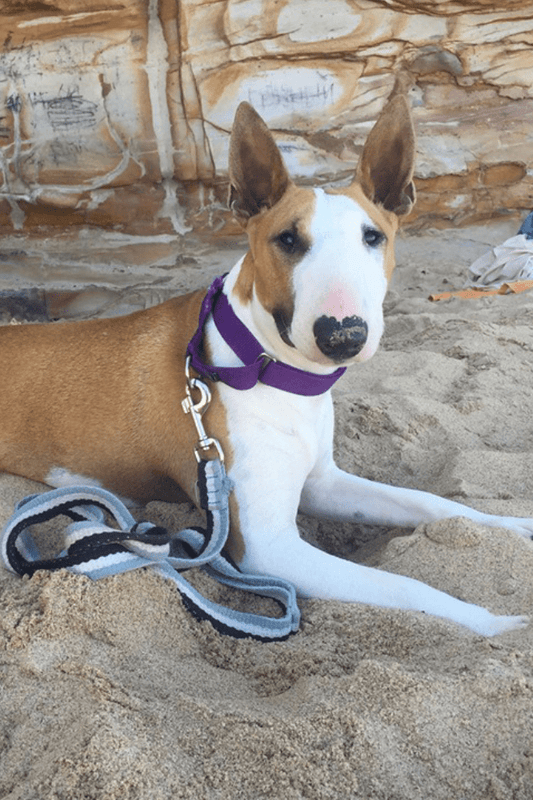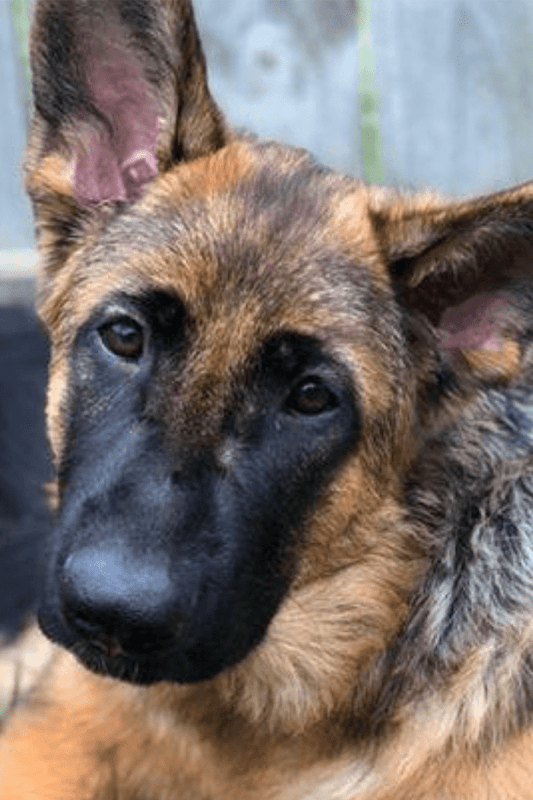A Walk In The Wild With
Gab and The Dingoes
Tell us about you, who are you, how long have you been involved with dingoes for (dingo den included):
I’m Gabriele Joy and I am an artist and wild canid nutritionist living in Australia. I’ve been involved with dingoes formally for almost 11 years, though they’ve been a part of my life since I was a child. Nine years ago they came back into my life most unexpectedly, in the form of a puppy who I had an instant connection with and who, though I’d never bought a puppy on such an impulse before, had to come home with me. I called him Uluru for his intense red coat. He was sold to me as a Kelpie cross, however after about 8 months it was clear to me that there was some dingo content, which DNA testing proved to be correct. By this point we were inseparable, and I remember thinking to myself (as I already worked with dingoes) how funny it was that I hadn’t planned to live with dingoes myself, yet this came about accidentally all the same! I wouldn’t have things any other way, though. Uluru is a very special soul.
A year after Uluru (nick-named Ru) came into my life, I also began volunteering with Dingo Den Animal Rescue, a Sydney-based sanctuary with a nationwide network of foster carers and volunteers. What initially drew me to the organisation was their work with and inclusion of dingo hybrids. I then learned that their animals were entirely raw fed, which quickly became my area of focus in assisting them, as dingo nutrition had been my primary interest and study since leaving behind my vet nursing training several years before.

Tell us about your dogs (dingoes included) and their breeds:
I have four: Uluru, Renn, Allira and Tori.
Uluru (Ru) is my oldest at now almost 9 years old. He’s my “heart dog” and I’m so grateful he came into my life. Ru’s a confident, outgoing boy with a hilarious sense of Aussie humour and a great love of farm adventures.
When he was 3, he was diagnosed with pannus (chronic superficial keratitis), which in his case is genetic. Pannus is an autoimmune disease that causes the body to reject the corneas of the eyes, sending white blood cells to grow scar tissue over them, eventually leading to blindness. It is worsened by exposure to sunlight, so he has a pair of RexSpecs K9 goggles he wears. There is no known cure, it’s a case of management for life. When he was first diagnosed, I was a mess of anxiety and sadness for him, this lasted a few days before I dove into researching the disorder and our options. Uluru’s pannus has been managed well all these years, with a mixture of nutritional, herbal and conventional options. He does have some vision loss, however his initial prognosis involved the likelihood of blindness by 5-6 years old, so at this point he has surprised everyone and is a very happy and healthy boy, which is the main thing. As his vision has begun to deteriorate in recent years, I’ve watched him cleverly adapt and we’ve all (the other animals and myself) made small adjustments to our routines to help accommodate his changing vision. I’m no longer that panicked pet owner I was at the time of his diagnosis, I’ve firmly believed in our teamwork for a long time now, and every day we prove just how far that can take us.
Renn is my 8 year-old cream working Kelpie, and though not related to Uluru, I call them both “brothers” as they are in every other way. Renn, like Ru, has been involved in many different dog sports over the years including rally-obedience, agility, herding and retrieving. Nick-named “Captain Sunshine,” Renn is an ever-smiling, sensitive boy whose favourite activities include swimming in the dam and playing chasey with Allira. Renn also helps to guide Ru when needed, and gently corrects Tori when her play style gets too rough. He is a great teacher to us all. Renn has pushed me to be a better trainer since he was 8 weeks old.
Tori, who will be 3 years old this year, is a Tropic dingo hybrid who I adopted through Dingo Den Animal Rescue. She was born in the wild and sadly orphaned at only a few weeks old, as very many dingoes and hybrids are due to the government bounties and lethal control methods. Tori was one of the lucky ones though, as she was found by kind people and had wonderful foster carers until I adopted her. Having more dingo genes than the others, her behaviours and communication style is distinct and unique in my little “pack.” Tori is incredibly loyal to us, patient and clear when communicating with Renn (the only 100% domestic dog), and such a happy girl. She certainly has her mischievous moments though and her and Uluru both remind me of one another frequently, so I guess it’s no surprise they get along excellently.
Allira came to me when she was 1 year-old as a foster, however it didn’t take long to see she was the perfect fit for all of us and the decision was made to adopt her. Allira, being half alpine dingo, is unique from the others again and I would say just unique in general. She makes me laugh so many times a day with her funny antics, I’ve worked with and lived with so many dogs and dingoes over the years, and I can honestly say Allira is not like anyone I’ve met before. Renn and Allira have become the best of friends, they almost speak the “same language,” and love playing chasey. They’re both quiet and sensitive, and help to bring balance to the confident, forward natures of Uluru and Tori. Allira, like Uluru, was not planned for and yet turned out to be just what our little pack was missing.
Allira’s favourite activities are zooming, recall training, and anything involving food puzzles… or food, in general. Allira loves food!


How do dingoes differ from domestic dogs?
Australian Dingoes are genetically, morphologically and behaviourally distinct from domestic dogs.
Genetically, we know that dingoes are not directly related to either domestic dogs or wolves, though they most likely share a common ancestor. From a nutrition perspective, they lack duplicate copies of the AMY2B gene for starch digestion, like wolves they don’t produce adequate pancreatic amylase to efficiently digest starches.
Morphologically, dingoes differ from domestic dogs almost literally from their nose to their tail. A dingo’s brain is around 30% larger than a domestic dogs. Dingoes have rotating wrists, legs capable of hyper-extension, and they can rotate their heads 180 degrees. Combine this with the fact that their skull is the widest part of their body, they can escape all kinds of tricky situations in the wild!
Other morphological differences include their longer canine and carnassial teeth than domestic dogs, and a higher bite force quotient due to their exaggerated occipital crest (comparatively larger than that of the grey wolf). Dingo eyes, being positioned at a 45-degree angle, also have a wider range of view than domestic dogs. Likewise, their ears are completely furred and they have an incredible range of hearing!
There are 3 dingo ecotypes, each of these is also distinct from one another. The ecotype that most people easily recognise as a dingo, is the thick-coated, fluffy Alpine. There are also Desert and Tropic dingoes.
Behaviourally, dingoes show a number of differences from domestic dogs, including being the only wild canid species documented using tools, and enjoying climbing to great heights including trees to gain better vantage points. Dingoes show many advanced problem-solving skills and prefer to work independently from humans, unlike dogs who will redirect onto people for assistance. Dingoes are very cat-like in their behaviour, their actions and communication styles being much more comparable with a cat’s than a dogs, for the most part.
Wild-born dingoes (and even some domestically born dingoes) tend to be naturally neophobic, meaning they have a phobia of anything new or changed, either in their own environment or if they are introduced to a whole new environment. This makes wild-borns even more aloof, shy and cautious, with extremely strong flight instincts.
What are some considerations that come with owning one?
There are practical considerations like tall fencing and a safe enclosure, suitable gear that they cannot slip free from for walking and ensuring you can provide a dingo-specific raw diet for them. It can also be beneficial, depending on the individual, to have a confident domestic dog already who can help build a dingo’s confidence and willingness to explore new spaces. I know that I alone would never have ever convinced Tori to explore the paddocks here, she learned to love them thanks to Uluru’s and Renn’s calm certainty. This is the same for many dingoes.
Having patience and a willingness to unlearn what you thought you knew about canine behaviour and/or training is also important, dingoes will teach you so much if you let them, and they will push you to be the best version of yourself for the overall energy of their family, as well. Building a bond with them is essential and the best place to focus your time in the early stages.
Many people believe dingoes cannot be trained; this is not the case. They are extraordinarily intelligent and can learn just about anything, however they will need more patience from you because impressing a human is not in their nature. They like to know the “why” behind things and understanding this through positive reinforcement and clear communication will help encourage them to learn important cues. When you have built the bond, they will love it when you are happy, and this helps towards teaching them behavioural cues.
Regardless how many cues they learn, though, none will ever be 100% proofed or reliable, as dingoes are very much like cats in that they will sometimes choose to simply not do something. This is completely understandable, as they are not domesticated animals.
Something that I would like to add to these considerations is a piece of advice I picked up from Kachina Canine Wellness: tell them what you’re doing, and what’s expected of them in certain situations. Talk to them, just like you would to another person – with respect and a normal tone of voice. It is the lynchpin of pack life for me and mine.

Does a dingoes diet vary from that of a domestic dog?
Yes. Dingoes have retained their primitive canid liver function, they don’t handle saturated animal fats well. They also lack the ability to adequately digest starches as they don’t have duplicate copies of the pancreatic amylase gene. These two factors mean they require a low-fat, well rounded raw diet based as much on wild prey proteins as possible; whilst starchy carbohydrates should be kept out of their diet. Dingo hybrids should have much the same diet as pure dingoes, because dingo genes are always dominant. The exception would be hybrids who are known to be low-content, without a doubt. If there’s any doubt though, it’s best to feed them as you would a dingo.
What made you passionate about dingoes and nutrition?
I’ve always been passionate about nutrition, I can’t think of any one place where it started, the intense interest has always been there… There are photos of me as a toddler, “cooking” pretend foods made from sticks and mud for the farm animals and my cat, during the preparation of which I would periodically scribble my “recipe” in pencil, onto pieces of scrap paper. I couldn’t write yet, and would apparently list off aloud what I was writing as I scribbled. In terms of enthusiasm nothing has changed, though thankfully the ingredients and my recipe presentation has improved!
I’ve always loved dogs and been surrounded by dogs and dingoes since a very young age, thanks mainly to a universal family interest in canines.
After school I started helping at both an animal shelter and a fauna park. The park fed a raw diet to their dingoes, where the animal shelter of course did not. I did not question the raw diets, but the kibble was so unusual to me at the time as my family all fed their dogs raw meats, bones and table scraps. I learned so much about raw feeding and about the different approaches to feeding animals through this experience.
Much later when I had started studying vet nursing, I got my first large breed dog: a German Shepherd who I called Caleb. I’d had a few dogs by that stage, but never such a large breed. Unfortunately I allowed myself to be convinced into feeding Caleb a breed-specific, popular brand of kibble with the reasoning that such a large dog needed this kibble for growth. He struggled with health issues his whole, short life, and whilst many of those were definitely no fault of the food, there is a possibility the food worsened them. I didn’t continue in vet nursing, instead I studied canine nutrition further, which lead me back to wild canid nutrition again and I was able to learn through some mentorships and other courses.
Around the same time, Caleb was diagnosed with a brain tumour at just 5 years old and I was advised he’d be lucky to live out the month. Applying what I was learning, I switched him to a raw diet high in healthy fats with additions such as medicinal mushroom tinctures, turmeric paste, raw butter and MCT oil. Caleb not only outlived his prognosis by 10 months, 8 of those were also the healthiest and happiest months of his life. His other health issues including allergies and skin issues cleared up, and the growth of the tumour slowed. It was Caleb who reinforced my belief in nutrition and fresh foods for all animals.

What kind of training do you do with Renn and your dingoes?
Kind of by accident, the most regular training we do revolves around paw targets, because I am a hobby photographer I ask for paw targeting constantly in conjunction with the cues “Look” and “Wait.” This helps me to ask them to stay in a particular place and hold eye contact with my camera lens while I take their photos. I often have my camera with me on our walks, camps and adventures, and regularly ask them to pose on a log or similar for photos. Their patience, willingness and enthusiasm for this never ceases to amaze me. Those cues are certainly fun but they’ve also come in handy in too many other practical situations to count. Dingoes naturally aren’t keen on holding eye contact with people, so teaching the “Look” cue so solidly has been so helpful in holding their focus both for teaching other behaviours, but also in keeping their attention on me during potentially stressful environments or situations.
Everyone except Allira started out at our 5-week puppy school classes, throughout which they learn basic obedience cues and, more importantly, social skills around other people and puppies. In Uluru’s and Tori’s case this helped build even more confidence and reinforced their focus on me in distracting situations. It also helped teach both of them good manners around other animals. In Renn’s case it helped as a base for teaching focus around distractions, though looking back Renn’s working-Kelpie-self was the most challenging puppy I’ve ever had in a puppy school setting, haha! By contrast, Tori was the easiest puppy I’ve ever had in puppy school. When I say “challenging” I refer to Renn’s difficulty sitting still and general working breed puppy excitability, and when I say “easiest” I’m describing how Tori would sit or lie down at my feet and calmly watch all the goings on with patient interest.

After puppy school, Uluru and Renn went on to work their way through obedience classes, after Advanced we worked on some formal obedience before enjoying rally-obedience and a bit of agility (though just for fun). Both boys have also been involved in herding and a range of different workshops over the years in disc, tricks, scent work and more. Uluru excelled in scent-work until eventually his vision (specifically depth perception) created more frustration for him than enjoyment in a formal scent-work environment, at which point I started setting up scent-work games at home and on friend’s and family’s farms.
Tori is likewise scent-work inclined, however due to her natural neophobia, training in a spacious, open club with all of their goings on would never have been an option for her. Instead, we enrolled in “Scent for Six” with the School of Canine Science (online), and again worked on this at home and in familiar places. Tori also loves puzzles, the more challenging the better as she will get quickly bored of basic ones. Her favourite at the moment is Nina Ottosson’s level 4 “Multipuzzle.” Tori is less keen on paw targets than the others, but she loves nose targets and hind-feet targets.
Allira enjoys recall training most of all, I think this is because it combines her love of zooming with food! She’s also very keen on trick training and short, engaging training games that don’t present too much of a challenge so she can have a lot of successes. Allira becomes easily frustrated with complicated tasks, so when teaching long behaviour chains I break them up in as many small stages as possible before linking them together. As I mentioned earlier, she’s unique among any dogs or dingoes I’ve ever known or worked with. You can’t spend any length of time with Allira without having the biggest grin on your face, though. She is such a character!

How long have you been using Antinol?
I started everyone on Antinol from the day Tori arrived home, so it must be 3 years now.
How do you think it assists them?
I give Antinol to each for different reasons:
Tori started on Antinol from puppyhood to assist her growth and cognitive development, and as I’ve mentioned, she was the calmest, most attentive puppy I’ve ever seen in a puppy school setting. One of the standout benefits of Antinol myself and our vet first noticed with Tori was the rapid improvement in Tori’s eyes. It’s very common for wild-born orphans to be much slower than other puppies in developing their eyes. At Tori’s first friendly visit to our vet for a general check-up a day or so after she came home, her eyes were the biggest concern of the vet’s. Just 5 days later, at the end of the week (and after being given Antinol daily), the vet was utterly astounded that Tori’s eyes were almost fully developed and were no longer a concern at all. After this, Antinol began showing up on the shelves of the clinic.
Uluru takes Antinol as part of his pannus (CSK) management. Initially, alongside conventional medications and prescription herbal formulas, part of Uluru’s dietary adjustment involved therapeutic doses of fish oil to help slow the progression of the white blood cells. This came with it’s own considerations including vitamin E supplementation and occasional upset stomachs. I switched him to Antinol instead, to achieve high doses of omega-3’s without any of the concerns about fish oil and it’s side effects. The change in Uluru’s eyes was visible within a month and measurable in his routine checks shortly after, the scar tissue on his corneas has been noticeably slower to progress since the change to Antinol.
Antinol Rapid helped even more again, with it’s inclusion of astaxanthin, a natural UV protectant carotenoid whose antioxidants are the only known to cross not only the blood-brain barrier but also the blood-retinal barrier.
Allira’s Antinol supplementation is to help relieve joint pain and offer as much prevention as possible from later joint related issues. Structurally, Allira is not totally sound and has always experienced some hip and knee inflammation on and off. Since beginning Antinol, Allira moves so differently that everyone comments how she “seems like a completely different animal.”
Renn, like Allira, takes Antinol as a preventative against future joint problems. Renn is now 8 years old and has had an incredibly active life thus far, he’s by far the most active of my four.

Tell us about your page Canine Ascension, how long you have had it, how are you hoping to inspire others?
Canine Ascension is a blog Facebook and Instagram page that I started in 2016 (2017 for Instagram), as a way of sharing how I feed my pack, in the hopes of inspiring and educating others who are looking to feed raw or wanting to expand their knowledge and gather new ideas. It quickly branched into sharing day-to-day enrichment, treat recipes, fermented food recipes, meal toppers, articles, meal prep, tips, honest product feedback, and nutrient analysis for proteins that are not quite so common in other parts of the world. At the time of starting the page, I honestly didn’t know what (if any) interest there would be in what I was posting, it started because of Caleb and Uluru, what we had been through and were continuing to go through. I felt that Caleb would’ve wanted me to share what I’d learned, so I started the page.
With 3 out of 4 of my little pack having dingo content and the 4th being a working dog, I’ve always been concerned that sharing meals would not be totally helpful to everyday pet owners, so I like to include in each of my posts a little about why I make certain decisions in my approach to nutrition and how those are chosen for the individuals. I sincerely hope that domestic dog, dingo and hybrid owners alike can all find something helpful to apply to their own animal’s diets. It makes me so happy to think of all the other animals in the world who are directly benefitting and thriving from all the time their humans are putting into reading pages like Canine Ascension and many others.
What is your favourite content to create?
I enjoy photography most of all, but when I sit down to write an article on anything regarding nutrition, I love that whole process too. In 2015 I started writing weekly posts called “Chewsdays” with Dingo Den Animal Rescue, about dingo-specific raw diets, nutrient requirements, food prep and anything else related to raw feeding for dingoes. If it hadn’t have been for all the encouragement from Dingo Den Animal Rescue to share this knowledge in a written format, I wouldn’t have realised how much I enjoyed the content creation process and I may not have even begun Canine Ascension.


